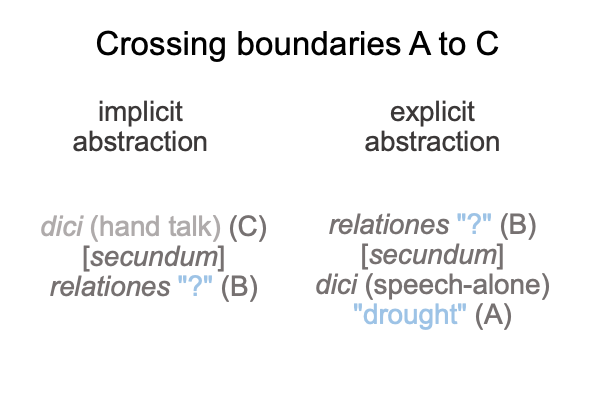0101 Oh my, this examination is already as long as the article.
Oh, maybe I can use a different label for what I am doing.
May I call this examination “a reconfiguration”?
The reconfiguration starts with a distinction between esse, dici (hand talk) and dici (speech-alone talk), drawing human evolution into the discussion.
In the long run, I suspect that Aquinas’s philosophy may be (to a significant degree) “re-expressed” using Peirce’s diagrams, if only because diagrams allow one to visualize a relation, as well as content within the relation.
Okay, maybe I should call this examination, “a speculation”.
0102 I conclude by offering a couple more blogs, with lots of pictures.
One blog focuses on the difference between implicit and explicit abstraction in regards to relationes secundum X.
The other blog concern the category-based nested form and how Peirce’s categories may be regarded in terms of explicit and implicit abstraction.
0103 I start with the counter-intuitive hand-talk statement discussed earlier.
Here is relationes secundum dici for this implicit abstraction.

0104 In the statement, each gesture-word categorically pictures or points to its referent. In doing so, each hand-talk wordassociates to matter. The form, here provided in speech-alone talk, is a relation that is counter-intuitive because ravens do not swim.
0105 But, maybe they do not have to.

0106 In speech-alone talk, the matter-slot is occupied by an interpretation (a relationes), corresponding to the form-slot for hand talk. The speech-alone word which solves the riddle of the slogan is “drought”. This word mimimizes contradictions to the extent that the interpretation only requires sensible construction.
0107 At this moment, I pose a question in regards the way that my attention proceeds in the previous two figures.
To me, it seems easy to proceed from (A) the matter-slot for implicit abstraction to (C) the form-slot for explicit abstraction. Dici (hand talk) flows through relationes to dici (speech-alone talk).

The other direction seems much more problematic. For example, if I say the word, “drought”, I do not spontaneously imagine that a drought allows ravens to pick up pebbles from the bottom of creeks.

The difficulties multiply when considering a return passage from dici (speech-alone talk) to dici (hand-talk).

